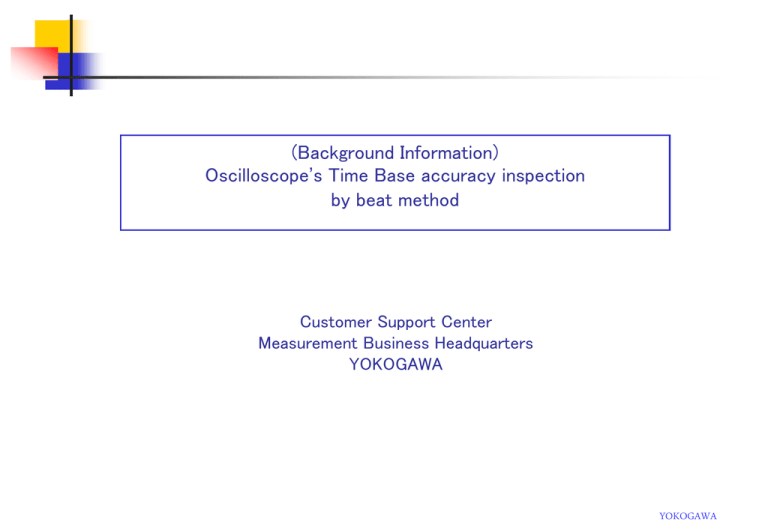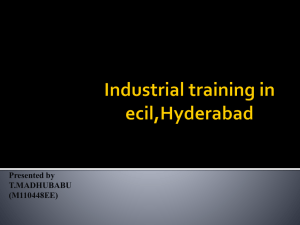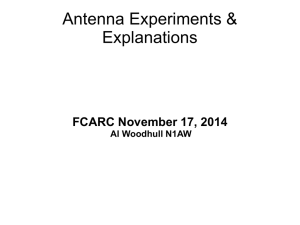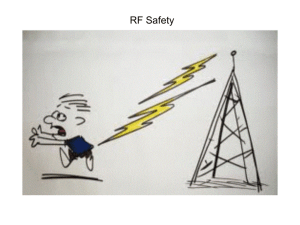beat method
advertisement

(Background Information) Oscilloscope’s Time Base accuracy inspection by beat method Customer Support Center Measurement Business Headquarters YOKOGAWA YOKOGAWA Aliasing effect of Digital Sampling Oscilloscopes If sampling rate is fast enough … It is possible to reconstruct the original waveform by interpolation. If sampling rate is not fast enough … It is impossible to reconstruct the original waveform by interpolation. Different waveform is observed. -> Aliasing Effect In general, oscilloscope’s sampling rate must be set to higher than 1/2 of the frequency of measured signal, to avoid aliasing problem. In “Beat Method”, on the other hand, we utilize this aliasing effect POSITIVELY. 2 YOKOGAWA Waveform Example A : 1/2fs < signal’s frequency < fs Let’s see how the actual aliasing waveforms look like. When oscilloscope’s sampling frequency is fs and the signal’s frequency is in between 1/2fs and fs, a waveform with lower frequency than the original signal would appear by aliasing effect. The following is a example of 9.995 MHz sine wave, sampled at fs = 10 MHz. The measured waveform will be a sine wave of 0.005 MHz (5 kHz). This alias waveform is called “beat waveform”. Sampling Frequency : 10 MHz Signal Frequency : 9.995 MHz Measured Waveform : abs(9.995-10) = 0.005 MHz 3 YOKOGAWA Waveform Example B : signal’s frequency = fs If the frequency of the input signal and the oscilloscope’s sampling rate are equal, there is only one sampled data in every cycle. Therefore, the measured waveform would not become a sine shaped any longer but it would be a horizontal line. The following two are examples of 10 MHz sine wave, measured at 10 MHz sampling. 4 YOKOGAWA Waveform Example C : signal’s frequency > fs When the signal’s frequency is higher than fs, then a waveform with lower frequency than the original would appear, just like Example A. The following is the example of 10.005 MHz sine wave measured at fs = 10 MHz. It will be 0.005 MHz (5 kHz) beat waveform. Sampling Frequency : 10 MHz Signal Frequency : 10.005 MHz Measured Waveform : abs(10.005-10) = 0.005 MHz 5 YOKOGAWA The relation between frequencies of input / measured The following figure shows the relation between “Measured frequency” and “Frequency of input signal”. As have observed so far, the measured frequency replicates between 0 and 1/2fs at every multiple of 1/2fs (1/2fs, 2/2fs, 3/2fs,…) on the horizontal axis by aliasing effect. Each observed aliasing waveform correspond to the point of Example A/B/C in the graph. Measured frequency replicates 1/2fs Example C Example A 0 1/2fs fs Example B 3/2fs Frequency of input signal fs : Oscilloscope’s sampling frequency (sampling rate) 6 YOKOGAWA Measured frequency is affected by time base error Now, let’s take “oscilloscope’s time base error” into consideration. If there are some error in an oscilloscope’s time base, the measured frequency would also include some error. This means that an oscilloscope’s time base error can be estimated by evaluating the deviation between the measured frequency and the correct value. Please remember that the measured frequency would also replicate between 0 and 1/2fs, regardless of the time base error. Time base is slow. > Measured frequency gets high. In order to simplify the explanation, the other error factors other than time base error are not considered. Also, the amount of error is emphasized than actual. Measured frequency Time base is fast. >Measured frequency gets low. replicates 1/2fs 0 No error 1/2fs fs 3/2fs Frequency of input signal 7 YOKOGAWA Improvement of frequency measurement accuracy by utilizing aliasing effect Usually, an oscilloscope’s time base error is very small. Therefore, its effect to the measured frequency is too small to measure directly at point (1) in the following graph. So we introduce the technique of utilizing aliasing effect and improve the accuracy of measurement. Concretely, inputs the signal with frequency of f1+fs and measures the frequency error of the “beat waveform”. By doing this, we can enlarge the frequency error exclusively, equivalent to point (2)’, with keeping the measurement frequency at f1. As a result, we can improve measurement accuracy dramatically. (2)’ Measured frequency 1/2fs (1) 0 f1 1/2fs (2) fs f1+fs Only error is enlarged by (fs+f1)/f1 3/2fs Frequency of input signal 8 YOKOGAWA Actual case of time base accuracy inspection (1) Let’s apply to an actual inspection procedure. DL1600 series’, for example, the specification is the following. Time base accuracy : +/-0.005% This is too small to measure directly. According to DL1600 series’ QIS (Quality Inspection Standards) procedure, “T/div : 5us/div, Record Length : 10k” is described for time base accuracy test. By theses settings, DL1600’s sampling frequency would be set to 200 MHz. The test signal should be 200.1 MHz sine wave with a frequency accuracy of 5 ppm or less. Checking should be done by a beat method that the frequency of aliasing waveforms meets the judgment criteria : +/-0.005 %. 9 YOKOGAWA Actual case of time base accuracy inspection (2) Let’s review the contents of the previous page closely. The frequency of the beat wave of 200.1 MHz, with fs of 200 MHz, would be 200.1MHz - fs = 0.1 MHz. Meanwhile, 0.005 % of 200.1 MHz is 0.01 MHz. So, if the beat waveform’s frequency meets the criteria of 0.1 MHz +/- 0.01 MHz, which is 0.09 to 0.11 MHz, then the time base error would be within the range of its specification. If the sampling interval is 200 MHz and the frequency to measure is 0.1 MHz, the measurement resolution is calculated as (0.1M)x(0.1M)/200M=50 Hz. This would be small enough for judgment criteria. If we try to measure 0.1 MHz directly, then the criteria must be 0.1 MHz x 0.005 % = 5Hz. This is too small to measure, because the frequency measurement resolution would be bigger than the criteria. 10 YOKOGAWA Conclusion As have explained so far, “Oscilloscope’s Time Base accuracy inspection by beat method” is one of the excellent measurement technique, by positively utilizing “aliasing effect”, which is considered one of the undesirable phenomena in general waveform measurement scenes. It can improve the dynamic range of frequency measurement, and therefore, enables accurate inspection of small time base error, which can be hardly measured directly. 11 YOKOGAWA





